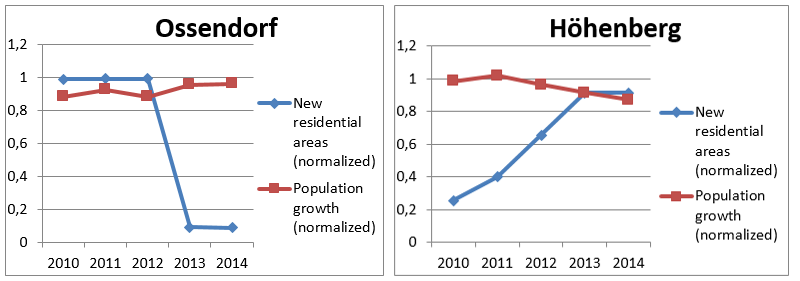By Jan Beutgen and Christopher Jensen.
For years the free living space in big German cities like Munich, Berlin and Cologne has been on the decrease, which leads to an expansion of the cities area. Many building sites can be found in the suburbs, while the capacity of buildings in the city center has almost reached its limit. But what will happen, when the population growth is on the rise in a district, that cannot keep up with creating new living space?
In this article the population growth in the districts of cologne is compared to the number of newly built residential areas. As a result, one can see how well the increasing population and the associated rising residential demand is being managed. Furthermore, it can be detected if any lack of living space or surplus of empty apartments can be expected in the near future.
The first dataset that has been used contains information on the number of new citizens in each district per thousand residents living in that district in the years from 2010-2014. The second dataset is showing the number of new apartments that have been finished in each district from 2010-2014. Then the slope for the population growth and the number of new apartments was calculated respectively. Finally, the slopes where subtracted to get the relation between population growth and the creation of living space. This value was used as input for the color map.
Explorative map of cologne
In the visualization above, you can see the map of cologne divided into its districts. The color is mapped from blue to red, whereby blue stands for an expected apartment surplus and the red color symbolizes a possible shortage of living space. For the minimum (Höhenberg) and maximum (Ossendorf) additional information on the background data is provided within the info boxes.
Overall the results are positive. The residential demand is being satisfied quite well, especially in the city center. Yet in some neighborhoods the increasing demand of the population growth is not being met and a shortage in living space can be expected in the near future. Examples are Ossendorf, Neuehrenfeld, Langel and Libur. The number of residential areas being built in those neighborhoods is on the decrease, while the number of new citizens is rising every year.
However, in some districts like Vingst, Mülheim, Elsdorf and Buchheim, the number of apartments being built was increasing over the years, while the population growth was static or shrinking. This means that we can expect a surplus of residential areas in those neighborhoods.
The maximum in terms of expected apartment shortage can be found in Ossendorf, if the trend of the past years keeps on. While the population growth was increasing over the years, the number of apartments built was drastically decreasing between 2012 and 2013.

The reason for the increase in population growth could be the lower rent index in comparison to other districts of cologne. But the main reason for Ossendorf to be on rank one, is the steep decline in number of built residential areas. This is due to the fact that a developing area in Ossendorf was completed in 2012 and the open residential space is scarce. Additionally, old buildings were in a poor condition and have to be renovated first, which reduces the number of new built apartments even more.
The exact opposite is Höhenberg, which suffers from a decreasing population growth, while at the same time new living space is created. The citizens are leaving the area for multiple facts.
At first there is a high unemployment rate in the area, since many nearby industrial factories have closed. Secondly not much renovation of the houses was done since the 1980s. Thus they are in a very bad condition. These facts explain the steady decrease in population growth. Höhenberg can be considered a deprived area. But recently some private investors have bought multiple houses and started the renovation. Furthermore, multiple projects support families in need and organize activities for the makeover of the neighborhood and increasing the cleanliness. Maybe this can lead to an increase in the neighborhoods attractively and will increase the population growth again.
Datasets used:
Number of Apartments: https://www.offenedaten-koeln.de/dataset/wohnverh%C3%A4ltnisse
Population growth: https://www.offenedaten-koeln.de/dataset/einwohnerbewegung
Be First to Comment